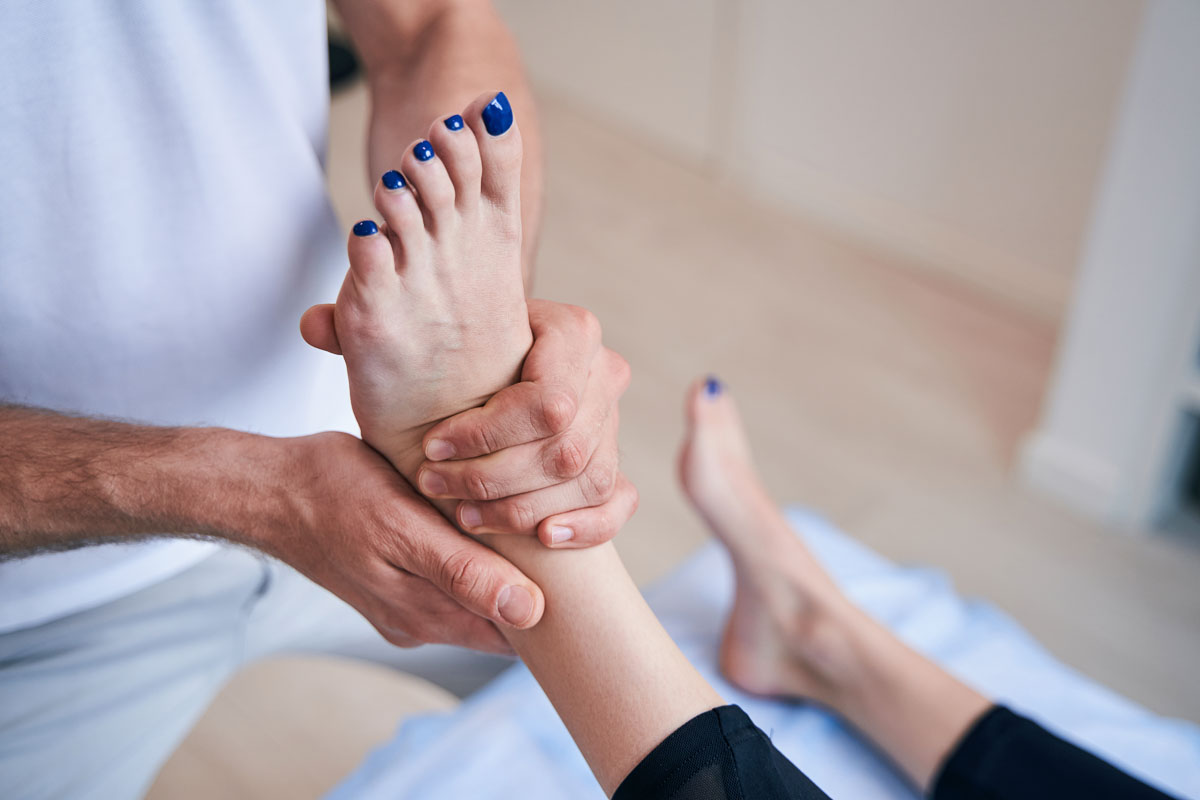According to leading experts, peripheral neuropathy affects over 20 million people in the United States and millions more around the world. Peripheral neuropathy can be caused by numerous conditions and may be accompanied by a range of symptoms.
The condition is a result of damage to the nerves located outside of the brain and spinal cord. These nerves are called peripheral nerves. When peripheral nerves are impaired, issues like numbness, weakness, tingling, pain, and even digestive problems could potentially occur.
Various treatments are available for peripheral neuropathy sufferers. These approaches can relieve symptoms and address underlying conditions. Although medications and surgeries are often used to treat peripheral neuropathy, many effective, non-invasive, and medication-free treatment alternatives are also available to investigate.
 At Apex Chiropractic, we take a multifaceted approach to treating peripheral neuropathy. With a 97% success rate in thousands of clients from all over the nation, our peripheral neuropathy treatments are available in Broomfield, Boulder, Erie, Thornton and greater Weld County, Colorado.
At Apex Chiropractic, we take a multifaceted approach to treating peripheral neuropathy. With a 97% success rate in thousands of clients from all over the nation, our peripheral neuropathy treatments are available in Broomfield, Boulder, Erie, Thornton and greater Weld County, Colorado.
In this in-depth peripheral neuropathy guide, we will go over everything you need to know including information on peripheral neuropathy, its potential treatments, reversing the condition, addressing symptoms at home, root causes, and non-surgical alternatives.
Read on to learn more or can contact our top-rated chiropractic clinic at (720) 328-1790 to speak with a chiropractic peripheral neuropathy specialist in Colorado now.
Are surgery and medication my only options for peripheral neuropathy?
Wondering if surgery or medications are your only options for treating peripheral neuropathy? The short answer is no. If you are suffering from peripheral neuropathy, you should know that there are many effective non-invasive treatment options available. In fact, many sufferers of peripheral neuropathy prefer non-invasive restorative techniques and benefit from them immensely.
However, to find the ideal treatment technique for your neuropathy, you will first need to understand its underlying cause or causes. Since peripheral neuropathy often manifests as a pain disorder, finding the best possible treatment for your unique situation is critical. After all, dealing with numbness, pain, digestive problems, tingling, and so on every day can significantly inhibit your ability to live your best life.
No matter what the root cause of your neuropathy might be, several effective surgery and medication-free treatments are readily available. These treatments can be used to help you manage your pain and reduce your symptoms. Many comprehensive non-invasive treatment approaches can even treat the underlying cause or causes of peripheral neuropathy. Often, these non-invasive treatment methods are highly successful. Especially when they are overseen by an experienced physician, chiropractor that is board certified in neuropathy, or therapist.
For the most effective treatment, you should first identify what the cause of your neuropathy is. That way, you can treat the problem at its source. For some root causes of neuropathy, non-invasive techniques can still be especially effective. In the meantime, you can implement an array of other non-surgery and medication-free techniques to manage your symptoms.
 Some non-invasive peripheral neuropathy treatment techniques include:
Some non-invasive peripheral neuropathy treatment techniques include:
- Chiropractic care
- Lifestyle changes to motion or physical activity
- Quitting smoking or drinking
- Cognitive therapy
- Nerve re-education therapy (TENS units DO NOT work for neuropathy)
- Occupational therapy
- Addressing nutritional problems and vitamin deficiencies
- Electromagnetic infrared therapy
- Massage
- Acupuncture
- Mind and body techniques like deep breathing, meditation, or yoga
- Cognitive or psychotherapeutic techniques
Five Symptoms of Peripheral Neuropathy
Since peripheral neuropathy results from damage to the nerves located near your spine and brain, symptoms like weakness, pain, numbness, and tingling in the hands and feet are most common.
However, peripheral neuropathy can be caused by various factors and may target different nerves. As such, symptoms of neuropathy have been known to manifest in other areas of the body as well.
Understanding Your Nervous System
The nervous system around your brain and spinal cord are known as your central nervous system. Your peripheral nervous system sends information from your spinal cord and brain to the rest of your body. Peripheral nerves also transmit sensory information to your central nervous system.
Each nerve in your peripheral system serves a specific function. So, the symptoms you experience will be dependent upon the nerves affected. Apart from impacting the nerves related directly to the peripheral nervous system, neuropathy can also impact bodily functions like digestion, circulation, and urination.
The different nervous system classifications are sensory, motor, and autonomic nerves. Neuropathy problems may exist in any or all of these systems. Symptoms may be gradual and worsen over time or sudden and extreme from the onset.
Mononeuropathy, Multiple Mononeuropathy, and Polyneuropathy
Peripheral neuropathy can affect one nerve in one area, multiple nerves in one area, a few nerves in different areas, or many nerves in many different areas. The extent/amount of damage and affected areas determine whether you have mononeuropathy, multiple mononeuropathies, or polyneuropathy.
Mononeuropathy: When peripheral neuropathy affects only one nerve, it is known as mononeuropathy. Examples of mononeuropathy are carpal or tarsal tunnel syndrome.
Multiple Mononeuropathies: When neuropathy affects two or more nerves in different regions, it is called multiple mononeuropathies.
Polyneuropathy: When neuropathy affects many nerves, it is called polyneuropathy. Most people with peripheral neuropathy have polyneuropathy.
Some symptoms of peripheral neuropathy are:
- The loss of your ability to notice changes in warmth and cold
- A reduced sensation of vibration and touch
- Feelings of pins and needles or hypersensitivity
- Feelings of increased pain or the inability to feel pain
- Sudden problems with coordination and balance
- Boring, burning, stabbing, lancing, or shooting pains, that might also worsen at night
 Five common symptoms of peripheral neuropathy explained
Five common symptoms of peripheral neuropathy explained
1. Numbness, Tingling, Prickling
One commonly reported symptom of peripheral neuropathy is a numb, prickling, or tingling sensation. Usually, this is in the hand or foot areas. This sensation may be sudden or gradual and can be mild or intense.
Sometimes, the tingling or numbness feeling will start with a light prickling or dullness that then spreads up your arms and legs. This initial sensation can turn into sharp jabbing pain or slow throbbing pain. Some even describe this feeling as burning or spreading heat.
2. Extreme Sensitivity to Touch or Unusual Sensory Feelings
Another common symptom of peripheral neuropathy is extreme sensitivity to touch, whether painful or simply disconcerting. This sensation often occurs when doing activities that should not otherwise cause pain. For example, some report feeling pain in their feet when putting weight on them when standing. Others felt pain from something as mild as putting on socks.
Some of Dr. Shane Kurth’s patients at Apex Chiropractic in Louisville, CO report feeling sensations of hot or cold that aren’t really there. For some people, peripheral neuropathy symptoms cause them to feel as if they are wearing socks or gloves when they are not.
3. Falls or Lack of Muscle Coordination
Falling, losing coordination, or experiencing sudden weakness may also indicate peripheral neuropathy. For instance, you could be lifting something heavy and unexpectedly find yourself dropping it because your muscles feel suddenly weak. Abruptly losing coordination and falling without a clear cause is another example.
4. Hot / Cold Intolerance or Dizziness
The intolerance of hot or cold temperatures is also often associated with peripheral neuropathy. This may be accompanied by excessive sweating or the inability to sweat. Some describe the feeling as being similar to having a hot flash or the chills.
For other people, peripheral neuropathy is accompanied by circulation problems. In these instances, people feel very cold or have hands and feet that are unusually chilly. Circulation problems or drops in blood pressure can also cause lightheadedness or a feeling of dizziness.
5. Digestive or Bladder Problems
Some sufferers of peripheral neuropathy experience digestive, bowel, or bladder issues. This may impact urination, bowel movement frequency, and more.
Five Types Of Treatment For Peripheral Neuropathy.
Here are a few of the most common non-invasive, surgery and medication-free, peripheral neuropathy treatment techniques.
1. Nerve Re-Education Therapy
One effective method for managing the pain caused by neuropathy is electrical nerve re-education therapy, which absolutely is not the same as Transcutaneous Electrical Nerve Stimulation. TENS is a treatment approach that does not work for neuropathy because the frequencies the device works off of are extremely fast. They can help temporarily with muscles but not actual neuropathic pain.
With this non-invasive treatment method, the proprietary device we use is specifically made for neuropathy and is used in the Cancer Treatment Centers of America for neuropathy caused by chemo. In some cases, in-patient visits aren’t necessary.
Although many clients who undergo nerve re-education therapy choose to do so at physicians’ offices, in-patient treatment is not always required. In fact, some nerve re-education units are even portable. This means they can be used at home, at the office, or on-demand anywhere else as needed. This allows the patient to be treated much more frequently, especially for advanced neuropathy cases.
While nerve re-education therapy is an efficacious method for reducing neuropathy pain, the underlying causes will still need to be addressed. Still, this method is a great option for people looking to cope with their neuropathy symptoms as they seek more permanent treatment methods.
2. Physical and or Occupational Therapy
Physical therapy involves using exercises, routines, massage therapy, and other external remedies to resolve problems that contribute to neuropathy. These may be issues with posture, coordination, and or muscle strength. If your neuropathy is linked to muscle weakness associated with motor damage, physical therapy can be especially beneficial.
Many occupational and physical therapists will also frequently suggest making changes to the way you move each day, perform certain activities, walk, sit, or even sleep. By changing the daily habits that are likely contributing to your pain, neuropathy symptoms can be reduced.
Occupational therapy is a form of physical therapy that addresses adapting or regaining certain functions. Usually, this will involve adjusting key functional activities that were impacted by nerve damage. An occupational therapist could also suggest utilizing detailed exercises, adaptive equipment, and adjusting how you perform certain daily activities.
3. Nutrition or Lifestyle Changes
Some vitamin deficiencies, lifestyle habits, and nutritional patterns have been known to cause, worsen, or contribute to neuropathy. As such, addressing these issues may be an effective way to treat peripheral neuropathy or reduce its symptoms.
Specifically, vitamin B-12 and folate deficiencies have been known to correlate with neuropathy issues. Consuming a well-balanced diet with fruits, vegetables, lean proteins, and whole grains, can prevent additional nerve damage from arising and help your body function better as a whole.
Moreover, tobacco products or the excessive consumption of alcohol have been known to play a role in nerve damage. Numerous programs are available to help neuropathy sufferers in Colorado quit smoking.
Limiting your daily alcohol intake can also effectively help toward reducing neuropathy symptoms. Experts recommend that peripheral neuropathy sufferers should consider limiting their alcoholic intake to no more than two drinks a day.
Regular physical activity is also an excellent way to reduce neuropathy symptoms. Daily exercise can help you maintain a healthy weight, regulate your blood sugar, improve muscle strength, and boost your mood.
Be sure to consult your physician before beginning a new exercise routine. Speaking with your doctor first is especially important if you are struggling with musculoskeletal damage or peripheral neuropathy.
4. Orthopedic Support and Chiropractic Care
Over 80% of neuropathy cases have a spinal component exacerbating their condition. The nerve roots in the neck control the arms and hands and the nerve roots in the lumbar spine control the legs and feet. When there is pressure on those specific roots chiropractic adjustments are one of the only non-invasive ways to alleviate that pressure. This will be necessary to actually heal the nerve damage long-term. Being treated by a chiropractor board-certified in neuropathy is one if the best non-invasive treatment models to help reverse neuropathy.
In some cases, braces and orthopedic support can help to reduce or eliminate neuropathy symptoms. For instance, individuals suffering from carpal or tarsal tunnel syndrome often benefit enormously from the use of wrist or ankle braces.
These splints and braces allow you to achieve ideal wrist and ankle positioning, giving your compressed nerves room to heal and eventually reducing inflammation. Diabetic socks and shoes can also reduce the risk of skin breakdown and provide added support for those who have peripheral neuropathy caused by diabetes.
5. Cognitive Therapy or Other Mind-Body Techniques
Many studies have proven that chronic stress is detrimental to individual health and wellness. As such, reducing stress in your life and practicing mindfulness can help with various bodily systems, including the nervous system.
Practices like yoga, meditation, Tai Chi, and deep breathing have proven effective in helping with a range of neurological and circulation problems. Typically, these techniques are used in tandem with other, more conventional practices.
Particularly, body and mind wellness methods can help sufferers of peripheral neuropathy lead more mindful lives with a better physical and mental affinity. In turn, this can work toward reducing pain, stress, and discomfort. All the while, these techniques improve your quality of life while promoting relaxation.
Yoga and Tai Chi can also assist with muscle tone and flexibility. Improving muscular performance and flexibility is a great way to improve your health as a whole. When approved by a doctor, these techniques tend to be gentle on the body while still encouraging better fitness.
 Can reversing my Type 2 diabetes, reverse my peripheral neuropathy?
Can reversing my Type 2 diabetes, reverse my peripheral neuropathy?
Wondering if you can reverse diabetic peripheral neuropathy? To understand the answer to this, it is important to first understand what diabetic peripheral neuropathy is and how it impacts the nervous system.
Diabetes can lead to a range of health issues. Due to high levels of glucose in the blood, careful management is necessary to prevent damage from taking place in the rest of the body. Diabetic neuropathy is a type of nerve damage that comes from diabetes.
Diabetic peripheral neuropathy can impact bodily functions in many ways. According to the NIDDK (National Institute for Diabetes and Digestive and Kidney Diseases), approximately 30% of people with diabetes will experience autonomic nervous system issues at some point. The nervous system controls automatic regulatory functions like digestion and circulation.
How many diabetics have peripheral neuropathy?
Studies suggest that up to 50% of people suffering from type 2 diabetes have peripheral neuropathy symptoms. Symptoms commonly appear in the feet, hands, legs, and arms. Focal or mononeuropathy may impact nerve compression and lead to tarsal or carpal tunnel syndrome. Carpal or tarsal tunnel syndrome is present in around 25% of people with diabetes.
Prevention and Early Treatment are Essential
Preventing diabetic neuropathy is the best course of action to take for those suffering from type 2 diabetes. To prevent diabetic neuropathy, it is critical to monitor and control blood sugar levels from the get-go. Staying on top of your blood sugar may reduce your risk of developing diabetic nerve damage by up to 50%.
Moreover, certain risk factors can increase the likelihood of people with diabetes developing neuropathy. These risk factors include a poor diet, smoking, being overweight, and having difficulty managing blood sugar levels.
Early identification and treatment are also important. Routine screening for type 2 diabetes after the age of 45 is important. This is especially true if you have various risk factors for diabetes. If you know you have type 2 diabetes and begin experiencing symptoms of peripheral neuropathy, speaking with your doctor and making healthy lifestyle changes right away can also be helpful.
Maintain the Healthiest Possible Lifestyle to Reduce the Risk of Diabetic Neuropathy
Lifestyle changes like maintaining a well-balanced diet, getting regular exercise, practicing vigilant blood sugar management, and lowering your cholesterol may decrease your likelihood of developing peripheral neuropathy if you have type 2 diabetes.
Stay On Top of Blood Sugar Levels and be Mindful of Neuropathy Symptoms
If you already have type 2 diabetes and notice symptoms like nausea, vomiting, pain, soreness, stiffness, constipation, diarrhea, impaired sexual function, urinary issues, muscle wasting, numbness, tingling sensations, or low blood pressure, speak with your physician as soon as possible. Frequent hand or foot skin infections that heal slowly or an impaired sense of hunger may also indicate the beginnings of diabetic neuropathy.
Those who do not have diabetes but start to notice the above symptoms should speak with a doctor about having high blood sugar levels. Regardless, controlling blood sugar levels is important. Then, start leading the healthiest possible lifestyle with regular exercise, mindfulness, and well-balanced nutrition. If you smoke or drink regularly, it may be time to quit.
Treat the Root Cause, Not Just the Symptoms
Many of the drugs that doctors prescribe to help treat diabetic neuropathy have been developed to target neuropathic symptoms. As such, they do not treat the underlying condition. A healthy lifestyle and the reduction of stress in your life can go a long way toward improving your health.
Diabetic Neuropathy is hard to Reverse
Unfortunately, nerve damage from diabetes is hard to reverse. Currently, there are only several proven ways to reduce diabetic neuropathy. It takes a comprehensive approach like the one Apex Chiropractic uses in Colorado but they do have a tremendous success rate even with the most advanced neuropathic cases. Scientists are working to develop more treatments that may be helpful in the future.
As such, the best approach to take on your own is to manage your blood sugar levels, lead a healthy lifestyle and keep your glucose within the target range. If you begin noticing diabetic neuropathy symptoms, it is recommended that you do everything practical to prevent your condition from worsening as soon as possible.
How Serious is Peripheral Neuropathy?
The effects and symptoms of peripheral neuropathy can vary based on a range of factors. In some instances, symptoms are mildly disabling. In other situations, peripheral neuropathy can be debilitating. This condition is known to put people in wheelchairs and lead to amputations if not attended to as soon as possible.
As such, if you begin experiencing peripheral neuropathy symptoms, you should speak with a health professional right away and begin considering your treatment options.
Neuropathy Severity and Symptoms Can Vary from Case to Case
Your neuropathy symptoms will depend on the nerve fibers impacted, the severity of your condition, and the type of nerve damage you are experiencing. Peripheral neuropathy symptoms can develop over many years, months, or sometimes, in just a few days.
In some instances, peripheral neuropathy symptoms will improve or go away on their own. Situations like this do not require advanced medical care. With that being said, this may serve as a warning sign to begin leading a healthier lifestyle.
Peripheral Nerve Cells are Known to Regenerate
Peripheral nerve cells differ from the nerve cells in your central nervous system, in that they continue to grow as life progresses. Additionally, certain forms of neuropathy involve damage to only a single nerve. It will all depend on your unique circumstances.
Ways To Relieve Your Peripheral Neuropathy At Home
The treatment methods that will be most effective for peripheral neuropathy will depend on the root cause of the neuropathy itself. Common treatments include surgery, injections, medications, and treatments for nerve pressure. Reducing inflammation may also be helpful.
However, many non-invasive approaches like chiropractic care are also available to help people manage and treat neuropathy. Here are some of the most effective natural treatments for peripheral neuropathy that can be done from home.
- Take the Right Vitamins
Sometimes, peripheral neuropathy is related to a vitamin deficiency. Vitamin B is essential to neurological health. A vitamin B deficiency may lead to nerve damage over time. Although you can get vitamin B from the nutrients you eat, your doctor might recommend taking additional supplements. Be sure to stick to your doctor’s recommended dose of vitamin B to prevent the worsening of your symptoms or toxicity. - Vitamin D may also help mitigate nerve pain. Typically, your skin will produce vitamin D as a response to natural sunlight. A deficiency in vitamin D may cause or worsen neuropathy symptoms. While taking a vitamin D supplement can be helpful, you should know that vitamin D is a hormone produced by the kidneys.
- Improve Your Circulation and Treat Nerve Pain with Heat or Capsaicin
If your peripheral neuropathy symptoms are bothering you, consider taking a warm bath or doing other activities that improve your circulation. As a rule, heat helps reduce nerve pain while cold helps with muscular pain.
Not only is taking a warm bath soothing, but it can help to improve blood circulation throughout your body. This can be effective when trying to decrease pain symptoms or numbness caused by neuropathy. Cayenne supplements have also been known to help improve circulatory issues. Cayenne pepper contains capsaicin. Capsaicin is the same ingredient that makes hot peppers taste spicy. Capsaicin can also be found in many topical creams and is known to have pain-relieving properties associated with circulation and reducing pain signals throughout the body. Capsaicin and cayenne pepper supplements are available at most grocery stores. Topical capsaicin ointments may also be helpful when approved by a physician. - Quit Smoking Right Away
This can not be emphasized enough. Smoking can negatively impact blood circulation. When you smoke frequently, your blood vessels become narrow. As such, oxygenated blood will have a harder time getting through. Poor blood circulation can increase numbness and pain from peripheral neuropathy. By eliminating any smoking habits, you can automatically begin improving your peripheral neuropathy symptoms. You will also reduce your risk of having a stroke, heart problems, and more. - Exercise and Stretch
Regular physical exercise may also improve your peripheral neuropathy symptoms. Not only that, but it can help combat pain and improve your health in general. Leading an active lifestyle has also been proven to reduce blood sugar. This can reduce or slow down the progression of nerve damage. So, consider exercising more often. Active stretching (not static) or doing yoga can also be effective. Active stretching improves circulation and can help with a range of musculoskeletal issues. Doing yoga helps increase mindfulness and when combined with deep breathing, improves oxygenation throughout the body. As always, talk to your doctor before beginning any new exercise regimen. - Reduce Inflammation
In some cases, neuropathy is caused or worsened by inflammation. There are many reasons that inflammation can occur in the body. For some people, activities like typing on the computer or standing up all day may lead to inflammation in areas like the wrists or ankles. Over-the-counter anti-inflammatory (NSAID) medications (like ibuprofen) can help to reduce inflammation from home but you need to be cautious with the side effects that come with them. Curcumin is a much safer and better alternative.
 What are natural remedies to help with my peripheral neuropathy
What are natural remedies to help with my peripheral neuropathy
Several natural treatments can be used to reduce your peripheral neuropathy symptoms. Some natural treatment methods may also help treat the root cause of neuropathy. It will all depend on your unique situation.
Here are a few natural remedies to consider.
- Therapeutic Chiropractic Care
In-clinic visits to chiropractic neuropathy specialists can help improve peripheral neuropathy problems. Some chiropractors help those suffering from peripheral neuropathy treat their condition without the use of surgery or medication. At Apex Chiropractic, for example, we offer a non-invasive and non-surgical, therapeutic approach to treating, reversing, and managing peripheral neuropathy. - Electromagnetic Infrared Therapy
Advancements in technology have shown that electromagnetic infrared therapy can be beneficial in treating peripheral neuropathy. Through electromagnetic infrared therapy, blood flow is increased to nerves. Low-Level Light Therapy (LLLT) can be used to signal Vaso Endothelial Growth (VEGF). This then signals the production of angiogenesis.
Angiogenesis involves the creation of new blood vessels. In turn, this leads to the repair of nerves and the reversal of nerve damage. These blood vessels can grow back around the peripheral nerves. They provide nerves and tissues with the proper nutrients required to repair and heal as nature intended. This form of therapeutic infrared technology has over 20 peer-reviewed studies as well as a 97% success rate with peripheral neuropathy. - Essential Oils and Acupuncture
Certain essential oils like Roman lavender and chamomile have been shown to increase circulation. These natural oils also have pain-relieving and anti-inflammatory effects. This could boost healing and help reduce neuropathy pain. - Acupuncture encourages natural recovery through the stimulation of the body’s pressure points. Acupuncture has been used by cultures around the world for hundreds of years. Through acupuncture, specific nerve triggers are stimulated to release chemicals.
These chemicals can transform your physical pain threshold and improve comfort. Acupuncture has also been shown to promote energy and improve your balance and mental well-being.
What are non-surgical options for peripheral neuropathy?
There are many non-surgical options for treating neuropathy pain, reducing the symptoms of peripheral neuropathy, and even reversing the condition itself. Non-surgical options include:
- Electromagnetic Infrared Therapy
Electromagnetic infrared therapy and low light therapy treatments for Vaso Endothelial Growth have been proven to help with neuropathy and nerve growth. - Circulation System Support
The reduction of inflammation and an improvement of circulation can help treat, reduce, and reverse some forms of neuropathy. - Lifestyle Changes
Improving your lifestyle by exercising more, quitting smoking, and reducing alcohol intake can go a long way toward eliminating neuropathy pain. - Electrostimulation
Electrostimulation for nerve re-education can be used to help heal and rebuild nerves. This form of treatment is another treatment option. It is offered as part of a four-prong treatment approach at Apex Chiropractic. - Physical Therapy and Chiropractic Care
Physical therapy, massage, and chiropractic care can be extremely effective for treating neuropathy. - Advanced Nutritional Therapy
Advanced nutritional therapy can help support your body’s nerves and tissue by providing key nutrients, vitamins, minerals, and more. - Other Holistic Methods
Meditation, deep breathing, acupuncture, and other similar methods may help reduce peripheral neuropathy pain. Essential oils and capsaicin may also be beneficial.
What causes peripheral neuropathy?
Peripheral neuropathy is a condition often characterized by damage to your peripheral nerves. These nerves are located in the nerve system at the base of your spine near your brain. This collection of nerves plays an important role in regulating a range of functions. The tissues from this location extend outward from the brain and spinal cord to areas like your muscles, limbs, organs, and more.
Since these nerves are vulnerable to damage, health conditions, injury, toxin exposure, and other factors can create issues over time. Let’s take a look at some common causes of peripheral neuropathy.
In many instances, peripheral neuropathy is idiopathic. This means that its cause is unknown. However, some known conditions often trigger peripheral neuropathy. These conditions include but are not limited to the following kidney disease, liver disease, diabetes, and injuries.
- Chronic Kidney or Liver Diseases
If the liver or kidneys are not functioning normally, an imbalance of salts and other chemicals can cause disorders like peripheral neuropathy. - Injuries
Broken bones, swelling, inflammation, and tight plaster casts can lead to neuropathy. In these situations, pressure is put directly on the nerves, leading to damage or neuropathy symptoms. - Infections
Some infections like HIV, Shingles, Lyme disease, and other viral illnesses can lead to damage to the nervous system. - Guillain-Barré syndrome
Guillain-Barré syndrome involves a specific type of neuropathy that is triggered after an infection. - Certain Autoimmune Disorders
Autoimmune disorders like rheumatoid arthritis, erythematosus, or systemic lupus have been known to cause peripheral neuropathy. - Cancer
Certain types of cancer including multiple myeloma and Lymphoma may cause neuropathy issues.
Other causes:
- Excessive alcohol intake
- Medications like chemotherapy or HIV treatment drugs
- Exposure to toxins like insecticides and solvents
- Deficiencies in B12 or folate
- Benign tumors
- Diabetic neuropathy
- Disorders of small blood vessels that reduce blood supply to the nerves and result in nerve tissue injury.
 What is peripheral neuropathy and how do I know if I have it?
What is peripheral neuropathy and how do I know if I have it?
Peripheral neuropathy is a nerve disorder that affects more than 20 million people in America. Usually, this condition causes abnormal nerve signals or distorted signals of pain. Peripheral neuropathy can affect various nerves. It may impact a range of different locations within the body or a singular area.
Examples of peripheral neuropathy include:
- Postherpetic neuralgia, which can follow shingles and endure for multiple months after the shingles rash disappears
- Ulnar nerve palsy
- Carpal tunnel syndrome, which involves compressed nerves in the wrist
- Tarsal tunnel syndrome, which involves compressed nerves in the ankles or feet
- Peroneal nerve palsy, which is induced by compaction of the fibular nerve
- Bell’s palsy, is a single-nerve neuropathy that influences the face.
The only way to determine whether you are actually suffering from peripheral neuropathy is to schedule a consultation with your health professional. Only a doctor, such as a chiropractor, can comprehensively diagnose neuropathy and its underlying cause. However, if you are experiencing symptoms like tingling, numbness, pain, loss of coordination, dizziness, or other neurological issues, contact a health professional right away.
While not all cases of neuropathy are serious, some types of neuropathy like diabetic neuropathy can cause permanent damage if left unchecked. With neuropathy, early diagnosis and treatment are important. The sooner you stop damage to your nerves, the better and faster they can heal.
Ready to Start Treating Your Peripheral Neuropathy in Colorado? Call Our Team Today!
Although millions of people suffer from peripheral neuropathy every day, you don’t have to count yourself among them. There are numerous non-invasive peripheral neuropathy treatments available that are free of medication and do not require surgery. If you would like to discuss your options with a peripheral neuropathy chiropractic specialist, contact our team.
At Apex Chiropractic, we serve peripheral neuropathy clients in Boulder, Broomfield, Thornton, Weld County, and the greater Denver surrounding areas. Using our multi-faceted approach, we help patients reduce and eliminate their symptoms while also addressing and treating the underlying causes of peripheral neuropathy.
To learn more or schedule an Apex Chiropractic consultation, click here, email info@apexchiroco.com, call, or text us now at (720) 328-1790.

Ready to See the Best Chiropractor in Louisville, CO?
Apex Chiropractic believes in thriving through life, not suffering in it. We believe that the activities that we want to partake in do not only desire but are necessary, just as necessary as our daily activities. In order to thrive in life and not suffer, we have to be completely in tune with our bodies. Schedule your appointment with us, today.
Like this article? Spread the word!
Related Posts
June 29, 2023
The Potential Mechanism of COVID Vaccine-Induced Peripheral Neuropathy: Numbness and Tingling in the Hands and Feet
Discover the potential mechanism behind COVID vaccine-induced peripheral neuropathy and…
June 9, 2023
Diabetic Neuropathy: Understanding the Connection Between Diabetes and Nerve Damage and How Chiropractic Care Can Help
Explore the connection between diabetes and nerve damage in our informative blog on…
April 10, 2023
Guide to Complex Regional Pain Syndrome
Complex regional pain syndrome causes substantial pain that interferes with completing…





